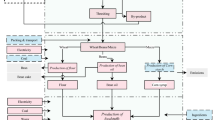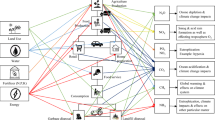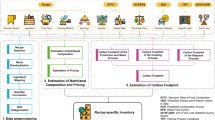Abstract
Purpose
The main purpose of this article is to assess the nutritional and economic efficiency of food loss and waste (FLW) along the supply of 13 food categories included in the Spanish food basket by means of the definition of a new method which combines two indexes.
Methods
The nutrient-rich foods index and the economic food loss and waste (EFLW) index were combined by means of linear programming to obtain the nutritional cost footprint (NCF) indicator under a life cycle perspective. The functional unit used was the daily supply of food for a Spanish citizen in year 2015.
Results and discussion
Results showed that vegetables and cereals were the food categories most affected by the inefficiencies in the food supply chain under a nutritional perspective, being agricultural production and household consumption the main stages in which the nutritional content of food is lost or wasted. Moreover, according to the NCF index, vegetables represented 27% of total nutritional-economic wastage throughout the entire Spanish agri-food chain. They are followed by fruits, which add up to 19%. Hence, specific food waste management strategies should be established for these specific products and supply stages. Finally, the sensitivity analysis performed highlighted that results were mostly independent from the importance attributed to either nutritional or economic variables.
Conclusions
The methodology described in this study proposes an indicator quantifying the nutritional-economic cost of different food categories in the Spanish food basket. This NCF indicator makes it possible to define reduction strategies to promote the use of food waste fractions for waste-to-energy valorization approaches or the extraction of different types of pharmacological, chemical, or cosmetic compounds.









Similar content being viewed by others
References
Akhtar S, Ismail T, Fraternale D, Sestili P (2015) Pomegranate peel and peel extracts: chemistry and food features. Food Chem 174:417–425
Batlle-Bayer L, Bala A, García-Herrero I, Lemaire E, Song G, Aldaco R, Fullana-i-Palmer P (2019) The Spanish dietary guidelines: a potential tool to reduce greenhouse gas emissions of current dietary patterns. J Clean Prod 213:588–598
Bradshaw C (2018) Waste law and the value of food. J Environ Law 30(2):311–331
Cristobal J, Castellani V, Manfredi S, Sala S (2008) Prioritizing and optimizing sustainable measures for food waste prevention and management. Waste Manag 72:3–16
Cuéllar AD, Webber ME (2010) Wasted food, wasted energy: the embedded energy in food waste in the United States. Environ Sci Technol 44(16):6464–6469
Datacomex (2018) Estadísticas del comercio exterior español. Agencia Española de Administración Tributaria. Retrieved from: http://datacomex.comercio.es/. Accessed 4 Feb 2019 (in Spanish)
de Souza R, Schincaglia R, Pimentel G, Mota J (2017) Nuts and human health outcomes: a systematic review. Nutrients 9(12):1311
Drewnowski A (2010) The nutrient rich foods index helps to identify healthy, affordable foods. Am J Clin Nutr 91:1095S–1101S
Drewnowski A, Maillot M, Darmon N (2008) Should nutrient profiles be based on 100 kcal, 100g or serving size? Eur J Clin Nutr 63(7):898–904
Drewnowski A, Maillot M, Darmon N (2009) Testing nutrient profile models in relation to energy density and energy cost. Eur J Clin Nutr 63(5):674–683
EFSA (2017) Dietary reference values for nutrients summary report. Retrieved from: https://doi.org/10.2903/sp.efsa.2017.e15121. Accessed 4 Feb 2019
Eriksson M, Strid I, Hansson PA (2015) Carbon footprint of food waste management options in the waste hierarchy—a Swedish case study. J Clean Prod 93:115–125
Eurostat (2015a) Fishery production in all fishing regions. Retrieved from: https://ec.europa.eu/eurostat/web/fisheries/data. Accessed 4 Feb 2019
Eurostat (2015b) Production and utilization of milk on the farm - annual data. Retrieved from: https://ec.europa.eu/eurostat/web/agriculture/data/database. Accessed 4 Feb 2019
Eurostat. (2015c) Slaughtering in slaughterhouses – annual data. Retrieved from: https://ec.europa.eu/eurostat/web/agriculture/data/database. Accessed 4 Feb 2019
Eurostat, (2015d) Crop products – annual data. Retrieved from: https://ec.europa.eu/eurostat/web/agriculture/data/database. Accessed 4 Feb 2019
FAO (2015) Food balance sheets, Spain 2013. Food and Agriculture Organization of the United Nations. Retrieved from: http://www.fao.org/faostat/en/#data/FBS. Accessed 4 Feb 2019
Farran A, Zamora R, Cervera P (2004) Tablas de composición de alimentos del CESNID. Retrieved from: http://www.sennutricion.org/es/2013/05/13/tablas-de-composicin-de-alimentos-del-cesnid. Accesed 5 Feb 2019 (*in Spanish)
Fulgoni VL, Keast DR, Drewnowski A (2009) Development and validation of the nutrient-rich foods index: a tool to measure nutritional quality of foods. J Nutr 139(8):1549–1554
García-Herrero I, Laso J, Margallo M, Bala A, Gazulla C, Fullana P, Vázquez-Rowe I, Irabien A, Aldaco R (2017) Incorporating linear programing and life cycle thinking into environmental sustainability decision-making: a case study on anchovy canning industry. Clean Techn Environ Policy 19(7):1897–1912
García-Herrero I, Hoehn D, Margallo M, Laso J, Bala A, Batlle-Bayer L, Fullana P, Vázquez-Rowe I, Gonzalez MJ, Durá MJ, Sarabia C, Abajas C, Amo-Setien FJ, Quiñones A, Aldaco R (2018) On the estimation of potential food waste reduction to support sustainable production and consumption policies. Food Policy 80:24–38
Grizzetti B, Pretato U, Lassaletta L, Billen G, Garnier J (2013) The contribution of food waste to global and European nitrogen pollution. Environ Sci Pol 33:186–195
Gustafsson J, Cederberg C, Sonesson U, Emanuelsson A (2013) The methodology of the FAO study: Global Food Losses and Food Waste-extent, causes and prevention”-FAO, 2011.
Guenther PM, Reedy J, Krebs-Smith SM (2008) Development of the healthy eating index-2005. J Am Diet Assoc 108(11):1896–1901
Gustavsson J, Cederberg C, Sonesson U, Van Otterdijk R, Meybeck A (2011) Global food losses and food waste; extent, causes and prevention. Swedish Institute for Food and Biotechnology (SIK), Gothenburg (Sweden), and FAO. Rome, Italy
Heller MC, Keoleian GA (2015) Greenhouse gas emission estimates of US dietary choices and food loss. J Ind Ecol 19(3):391–401
Hellweg S, Milà i Canals L (2014) Emerging approaches, challenges and opportunities in life cycle assessment. Science 344(6188):1109–1113
Iñarra B, Bald C, Cebrián M, Antelo LT, Franco-Uría A, Vázquez JA, Pérez-Martín RI, Zufía J (2019) What to do with unwanted catches: valorisation options and selection strategies. In: The European landing obligation. Springer, Cham, pp 333–359
ISO (2006a) ISO 14040: Environmental management-life cycle assessment - principles and framework. International Standards Organization, Geneva
ISO (2006b) ISO 14044: Environmental management-life cycle assessment – requirements and management. International Standards Organization, Geneva
Kennedy ET, Ohls J, Carlson S, Fleming K (1995) The healthy eating index: design and applications. J Am Diet Assoc 95(10):1103–1108
Khoddami A, Roberts TH (2015) Pomegranate oil as a valuable pharmaceutical and nutraceutical. Lipid Technol 27(2):40–42
Laso J, Hoehn D, Margallo M, García-Herrero I, Batlle-Bayer L, Bala A, Fullana P, Vázquez-Rowe I, Irabien A, Aldaco R (2018a) Assessing energy and environmental efficiency of the Spanish agri-food system using the LCA/DEA methodology. Energies 11(12):3395
Laso J, García-Herrero I, Margallo M, Vázquez-Rowe I, Fullana P, Bala A, Gazulla C, Irabien A, Aldaco R (2018b) Finding an economic and environmental balance in value chains based on circular economy thinking: an eco-efficiency methodology applied to the fish canning industry. Resour Conserv Recycl 133:428–437
Lin CSK, Pfaltzgraff LA, Herrero-Davila L, Mubofu EB, Abderrahim S, Clark JH, Koutinas AA, Kopsahelis N, Stamatelatou K, Dickson F, Thankappan S, Mohamed Z, Brocklesby R, Luque R (2013) Food waste as a valuable resource for the production of chemicals, materials and fuels. Current situation and global perspective. Energy Environ Sci 6(2):426–464
Lovejoy JC (2005) The impact of nuts on diabetes and diabetes risk. Curr Diab Rep 5(5):379–384
MAPAMA (2013) Las pérdidas y el desperdicio alimentario generado por la producción agrícola de alimentos en España. Spanish Ministry of Agriculture, Fishery, Food and Enviroment. Retrieved from: https://www.mapa.gob.es/es/alimentacion/temas/estrategia-mas-alimento-menos-desperdicio/Memoria%20de%20actividades_2013_tcm30-78798.pdf. Accessed 4 Feb 2019 (in Spanish)
MAPAMA (2015) Ministry of Agriculture, Fishery, Food and Environment. Agricultural statistics-National average prices. Retrieved from: https://www.mapa.gob.es/app/precios-medios-nacionales/pmn_tabla.asp. Accessed 6 May 2019 (in Spanish)
MAPAMA (2017) Spanish Ministry of Agriculture, Fishery, Food and Environment. Household Consumption. Database. Retrieved from: www.mapama.gob.es/es/alimentacion/temas/consumo-y-comercializacion-y- distribucion-alimentaria/panel-de-consumo-alimentario/base-de-datos-de-consumo-en-hogares/. Accessed 5 Feb 2019 (*in Spanish)
MINECO (2015) Ministry of Economy and Competitiveness. Prices at source and destination. Retrieved from: http://www.comercio.gob.es/es-ES/comercio-interior/Precios-Comerciales/Informacion-de-precios-(bases-de-datos)/Paginas/Precios-Origen-Destino-.aspx. Accessed 6 May 2019 (in Spanish)
M T Streppel, D Sluik, J F van Yperen, A Geelen, A Hofman, O H Franco, J C M Witteman, E J M Feskens, (2014) Nutrient-rich foods, cardiovascular diseases and all-cause mortality: the Rotterdam study. European Journal of Clinical Nutrition 68 (6):741-747
Nemecek T, Jungbluth N, i Canals LM, Schenck R (2016) Environmental impacts of food consumption and nutrition: where are we and what is next? Int J Life Cycle Assess 21(5):607–620
Pimentel D, Pimentel MH (eds) (2008) Food, energy, and society. CRC Press, Boca Raton
Ravindran R, Jaiswal AK (2016) Exploitation of food industry waste for high-value products. Trends Biotechnol 34(1):58–69
Sluik D, Streppel MT, van Lee L, Geelen A, Feskens E (2015) Evaluantion of a nutrient-rich food index score in the Netherlands. J Nutr Sci 4(14):1–9
Stokstad E (2019) Ships banned from throwing unwanted fish overboard. Science 363(6423):112–113
Suresh PV, Kudre TG, Johny LC (2018) Sustainable valorization of seafood processing by-product/discard. In: Singhania R, Agarwal R, Kumar R, Sukumaran R (eds) Waste to wealth. Energy, environment, and sustainability. Springer, Singapore
UN (2019) Sustainable Development Goal 12 – ensure sustainable consumption and production patterns. United Nations. Retrieved from: https://sustainabledevelopment.un.org/sdg12. Accessed 4 Feb 2019
Vázquez JA, Fernández-Compás A, Blanco M, Rodríguez-Amado I, Moreno H, Borderías J, Pérez-Martín RI (2019) Development of bioprocesses for the integral valorisation of fish discards. Biochem Eng J 144:198–208
Vazquez-Rowe I, Moreira MT, Feijoo G (2011) Estimating global discards and their potential reduction for the Galician fishing fleet (NW Spain). Mar Policy 35(2):140–147
Vázquez-Rowe I, Larrea-Gallegos G, Villanueva-Rey P, Gilardino A (2017a) Climate change mitigation opportunities based on carbon footprint estimates of dietary patterns in Peru. PloSOne 12(11):e0188182
Vázquez-Rowe I, Kahhat R, Santillán-Saldívar J, Quispe I, Bentín M (2017b) Carbon footprint of pomegranate (Punica granatum) cultivation in a hyper-arid region in coastal Peru. Int J Life Cycle Assess 22(4):601–617
Vilariño MV, Franco C, Quarrington C (2017) Food loss and waste reduction as an integral part of a circular economy. Front Environ Sci 5:21
WHO (2015) Healthy Diet. Fact Sheet N°394. September 2015. World Health Organization. Retrieved from: https://www.who.int/en/news-room/fact-sheets/detail/healthy-diet. Accessed 5 Feb 2019
Yago Lorenzo-Toja, Ian Vázquez-Rowe, María José Amores, Montserrat Termes-Rifé, Desirée Marín-Navarro, María Teresa Moreira, Gumersindo Feijoo, (2016) Benchmarking wastewater treatment plants under an eco-efficiency perspective. Science of The Total Environment 566-567:468-479
Yan N, Chen X (2015) Sustainability: don’t waste seafood waste. Nat News 524(7564):155–157
Yang Y (2016) Toward a more accurate regionalized life cycle inventory. J Clean Prod 112:308–315
Funding
The authors are grateful for the funding of the Spanish Ministry of Economy and Competitiveness through the Ceres-Procom: Food production and consumption strategies for climate change mitigation (CTM2016-76176-C2-1-R) (AEI/FEDER, UE).
Author information
Authors and Affiliations
Corresponding author
Additional information
Responsible editor: Niels Jungbluth
Publisher’s note
Springer Nature remains neutral with regard to jurisdictional claims in published maps and institutional affiliations.
Electronic supplementary material
ESM 1
(DOCX 98 kb)
Rights and permissions
About this article
Cite this article
Vázquez-Rowe, I., Laso, J., Margallo, M. et al. Food loss and waste metrics: a proposed nutritional cost footprint linking linear programming and life cycle assessment. Int J Life Cycle Assess 25, 1197–1209 (2020). https://doi.org/10.1007/s11367-019-01655-1
Received:
Accepted:
Published:
Issue Date:
DOI: https://doi.org/10.1007/s11367-019-01655-1




